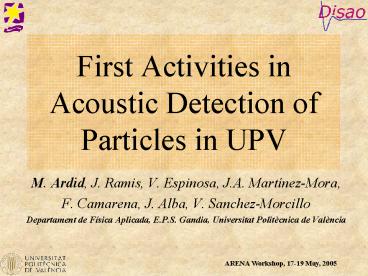First Activities in Acoustic Detection of Particles in UPV PowerPoint PPT Presentation
Title: First Activities in Acoustic Detection of Particles in UPV
1
First Activities in Acoustic Detection of
Particles in UPV
- M. Ardid, J. Ramis, V. Espinosa, J.A.
Martínez-Mora, - F. Camarena, J. Alba, V. Sanchez-Morcillo
- Departament de Física Aplicada, E.P.S. Gandia,
Universitat Politècnica de València
2
Contents
- DISAO group
- Experience in acoustic fields and connections
with neutrino detection - First activities related to particle detection
- Design of piezoelectric transducers
- Characterization and calibration of hydrophones
- Simulation of the propagation of the signal in
the sea - Conclusions and future
3
DISAO group
14 researchers working in (3 of them with Ph.D.
in experimental particle physics)
- ULTRASOUNDS TRANSDUCTION
- Non-destructive analysis (fruits, leakages)
Materials - Positioning Vibroacoustics, holography
- Biomass in fisheries Piezoelectrics
- Neutrino detection Difussors, room
acoustics - Thermoacoustic Model Quality of
sound - Intense beams Noise mapping
- NON-LINEAR ACOUSTICS PSYCHOACOUSTICS
4
DISAO group
14 researchers working in
- ULTRASOUNDS
- TRANSDUCTION
- NON-LINEAR ACOUSTICS
- PSYCHOACOUSTICS
Non-destructive analysis
Materials
Holography
Positioning
Piezoelectrics
Biomass in fisheries
NEUTRINO DETECTION
Vibroacoustics
Thermoacoustic model
Diffusors
Room acoustics
Intense beams
Quality of sound
Noise mapping
5
Connections with neutrino detection
- Transducers of ultrasounds
- Example of application Non-destructive analysis
of fruits
6
Connections with neutrino detection
- Studies in the sea
- Example of application study of biomass in
fisheries
7
Connections with neutrino detection
- Non-linear acoustics
Intense beams
Thermoacoustic resonator
Self-trapped states of sound
Self-organization of sound
8
First activities related to neutrino detection
9
Design of piezoelectrics transducers
- Software based on the localized constants method
using the modified KLM model, R. Krimholtz et
al., Electronic Letters 6 (1970)
10
Design of piezoelectrics transducers
- Simulation of the whole transducer (not only the
piezoelectric)
Friendly interface
11
Design of piezoelectrics transducers
Excitation Response in Time and Frequency
Emitting and Receiving Transfer Functions
- Results
Input acoustic impedance
12
Design of piezoelectrics transducers
- Next steps
- Exhaustive comparison between simulation and
experimental results - Comparison of the results with finite element
methods - Include piezoelectrics with different geometries
(not only discs/cylinders) - Upgrade the model including more effects by using
secondary circuits - Use it, to design the best piezoelectrics sensors
for acoustic detection of neutrinos - Future
- Include the improved model in the simulation
package for acoustic detection of neutrinos
13
Characterization and calibration of hydrophones
- The calibration of hydrophones in the lab is not
an easy task - There are reflections, diffraction, etc, which
could affect well-known methods of calibration
like the reciprocity method. - We are working in designing a method for
hydrophone calibration
14
Characterization and calibration of hydrophones
- MLS (Maximum Length Sequence) signal
- Pseudo-random signal, analogical version of
digital sequence consisting of values 1 and -1. - Periodic with the period T2N - 1, where N is the
"order of the sequence", and has a flat frequency
distribution. - Circular autocorrelation provides a delta
function
MLS order 6
15
Characterization and calibration of hydrophones
- Time and frequency response of the system (two
hydrophones tank) using the MLS signal - knowing the response of two elements, we could
know the third one
16
Characterization and calibration of hydrophones
- Next steps
- Learn more about the different effects involved
in acoustic calibration of hydrophones - Study the calibration with different signals
(short signals with few pulses, white noise,
continuous waves, sweep signal, MLS) - Improve the conditions of measurement and
calibration of the lab building an anechoic tank - Design a trustful system of calibration in the
lab - Look for a good and simple neutrino signal
for calibration - Future
- Design and characterize different sensors for
neutrino detection - Design a trustful system of calibration in
neutrino detection sites
17
Simulation of the propagation of the signal in
the sea
- Since recently we are using The Acoustic ToolBox,
which includes four acoustic models - BELLHOP A beam/ray trace code
- KRAKEN A normal mode code
- SCOOTER A finite element FFP code
- SPARC A time domain FFP code
- We show the application of this code to learn
about the contribution of the sea surface noise
to the deep-water noise in the Mediterranean Sea.
18
Simulation of the propagation of the signal in
the sea
- BELLHOP beam/ray tracing. The rays with small
angles of emission are curved and do not reach
the deep sea.
19
Simulation of the propagation of the signal in
the sea
- Transmission loss for the propagation of sound in
the Mediterranean Sea for a source in the surface
and measuring in the sea floor for different
depths given by the normal mode code KRAKEN.
f 1 kHz
f 15 kHz, no absorp. in water
20
Simulation of the propagation of the signal in
the sea
- Next steps
- Learn more about acoustical oceanography codes
- Include some effects, which are not taken yet
into consideration - Use the parameters of possible neutrino detector
sites (if available) - Compare the results with other simulation
packages and validate them - Upgrade the model for acoustic neutrino detection
purposes. - Future
- Include the improved model in the simulation
package for acoustic detection of neutrinos - Use it for the inverse problem, neutrino source
location
21
Conclusions and Future
- Conclusions
- We have started to work in some aspects of
acoustic neutrino detection design of
piezoelectric transducers, calibration of
hydrophones and propagation of acoustic signal in
the sea, reaching some results but knowing that
there is a long way still. - We have seen that we can apply knowledge from
different acoustic fields to the neutrino
detection problem - Therefore, multidisciplinary collaboration of
acoustic and particle physics people is
encouraged - Future
- To consolidate this line of research in our group
- To participate in an international collaboration
which faces this complex problem in an organised
and efficient way.

